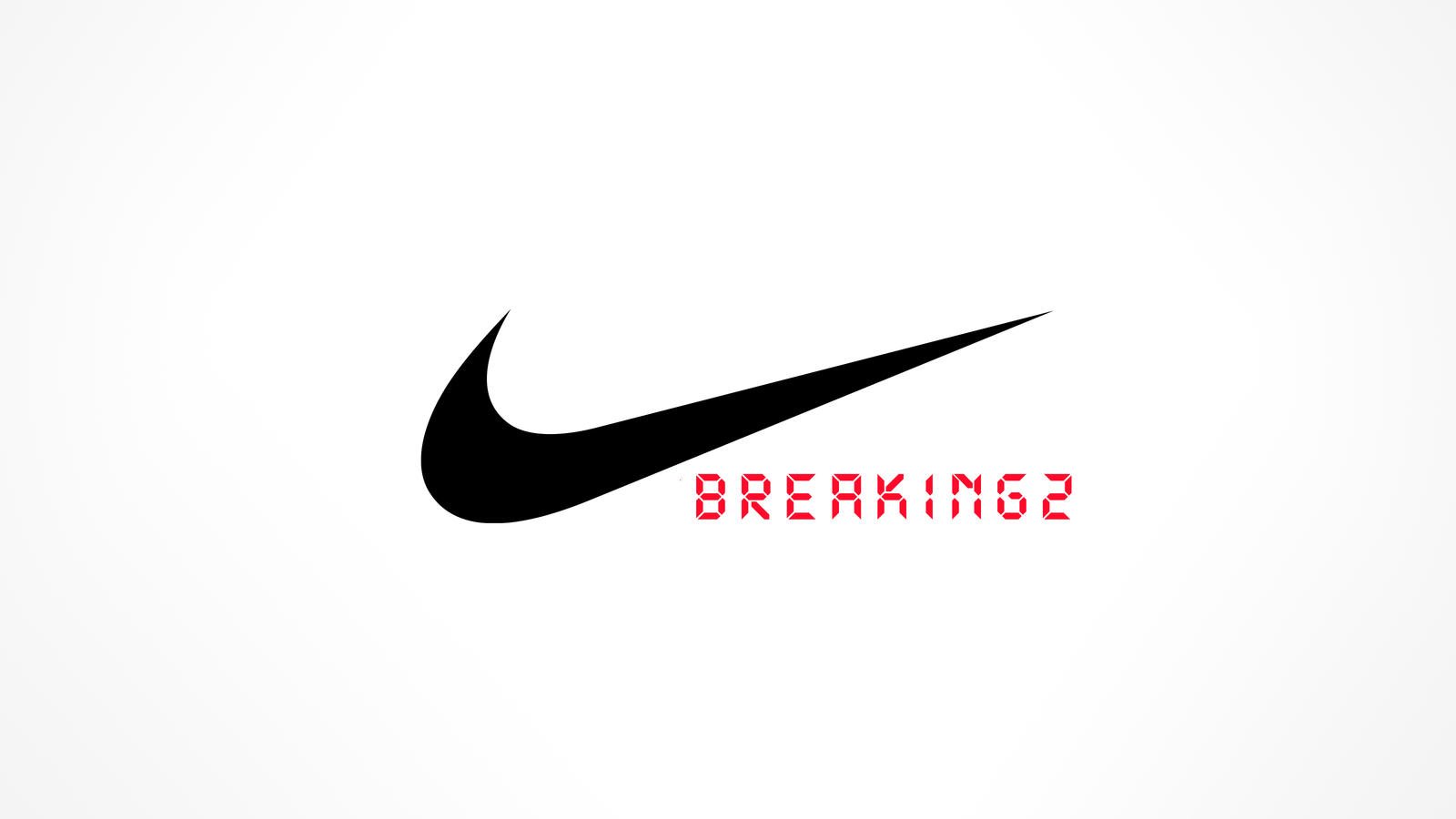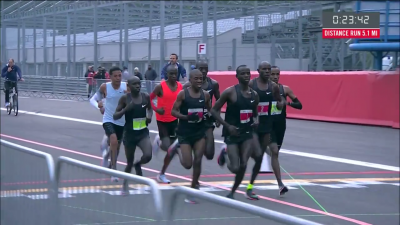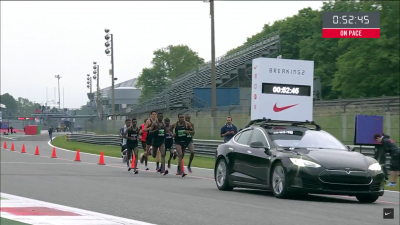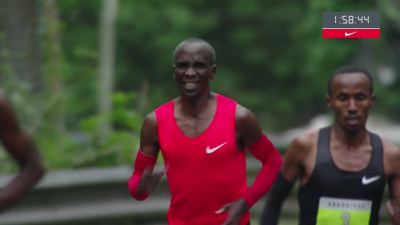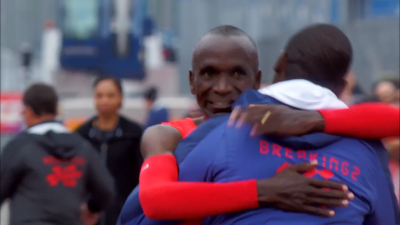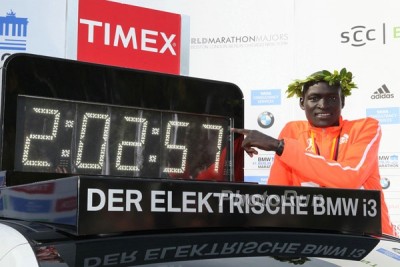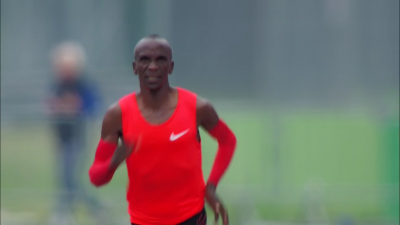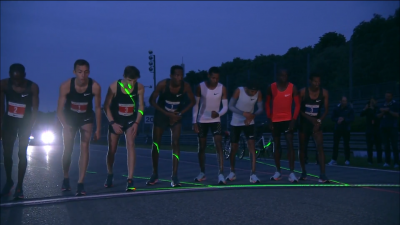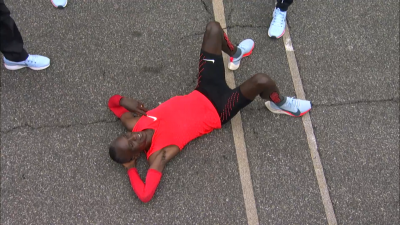Breaking2 Falls Short, But Eliud Kipchoge Runs an Astonishing 2:00:25 for the Marathon Distance
By LetsRun.com
May 6, 2017
In a supreme display of fitness, Kenya’s Eliud Kipchoge covered the 26.2-mile marathon distance in 2:00:25 this morning at the Autodromo Nazionale Monza in Italy, 2:32 faster than anyone else in history. Though Kipchoge’s audacious attempt to break the two-hour barrier, branded by his sponsor Nike as Breaking2, fell short, he showed the world what was possible when the greatest marathoner in history is given the chance to take advantage of conditions that would never exist in a major big-city marathon.
“The world now is just 25 seconds away,” Kipchoge said after the event.
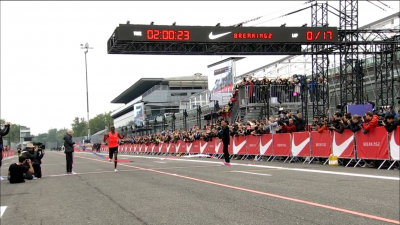 Kipchoge nears the finishline
Kipchoge nears the finishline
While the rotating phalanx of pacers — who ran in front of Kipchoge until the final meters — and the ability to have his drinks delivered to him on the go may have helped, the primary reason, by far, for Kipchoge’s stellar time was Eliud Kipchoge himself. Neither of the two other athletes Nike contracted for the attempt, Ethiopia’s Lelisa Desisa (2:14:10 final time) and Eritrea’s Zersenay Tadese (2:06:51), made it even halfway at 2:00:00 marathon pace. Kipchoge managed it for almost the entire distance. He showed, once again, that he has no peer among the world’s marathoners; in fact, few individuals in any field can claim the same degree of mastery as Kipchoge possesses when he runs 26.2 miles. No matter what you thought of this attempt, it was impossible, upon watching Kipchoge cross the finish line and embrace his longtime coach Patrick Sang, not to feel respect and admiration for the man’s desire, talent, and enormous self-belief.
Kipchoge’s 2:00:25 will not be ratified as the official world record as the use of rotating pacers and the on-demand drink delivery did not adhere to IAAF regulations. But the time will lead to fevered discussion across the running world. Prior to the race, few members of the running cognoscenti believed sub-2:00 was possible on a legitimate course, even with illegal pacing. Yet had Kipchoge run just one second per mile faster today, he would have broken 2:00. How soon can someone actually break 2:00? And what was Kipchoge’s performance today worth in a traditional big city marathon such as Berlin?
Recap
Conditions for the attempt, which began in the dark at 5:45 a.m. local time in Monza (the sun would not rise for another 20 minutes), were good: 53 degrees and cloudy, with no significant wind. The early stages of the attempt followed Nike’s plan closely, with a group of six pacers, (three of them would sub in and out each lap), running in an arrowhead or flying “V” formation. As they led the three marathoners through the first 5k in 14:14, just a hair over 2:00:00 pace (2:00:06), not only were the pacers running in a set flying “V” formation, designed to more optimally break the wind, they were closely following a pace car. The car not only set the pace and created its own draft, but was mounted with green lasers that shot backward to create a “box” for the pacers to run in.
The men covered the second 5k in 14:07 (28:21 at 10k), and from here to the finish, Kipchoge crushed every single “fastest split to start a marathon” stat in existence. But the splits revealed that the pacing, while more even than any elite marathon before it, was not perfect. One of the 2.4k laps was run in 6:44, the next in 6:37, the next in 6:51.
Even at that early stage, however, Desisa was already looking uncomfortable, and as the runners completed their seventh full lap 2.4-kilometer lap (18,198m total had elapsed as they began with an abbreviated first lap), he could hold on no longer. One lap later, Tadese began to tire, and he, too, was off the pace before they had even hit halfway (a halfway split was not given on the broadcast). Eliud Kipchoge was Nike’s only chance to save the day.
Fortunately for them, Kipchoge is a far greater marathoner than either Desisa or Tadese, and if Kipchoge was feeling any ill effects for running the fastest half marathon split of anyone in history — by over a minute — he was not showing them. His stride remained unchanged. His expression revealed no strain.
Kipchoge continued to hit his splits, running 14:14 for his fifth 5k segment and 14:17 for his sixth, either one of those a headline in and of itself in a normal marathon. He passed 30 kilometers in 1:25:20, on pace for a 2:00:01 finishing time. He ran another 14:17 from 30k to 35k (1:39:37, 2:00:05 projected time). He had less than five miles to go and was almost on pace. And what’s more, he looked terrific, his form unchanged from mile 1. Even his most ardent doubters began to hear a quiet voice in the back of their heads. Could he actually do this?
Sadly for Kipchoge, this is where the dream began to fall apart. At 23 miles, the flying “V” pacer formation began to string out as Kipchoge struggled to maintain contact with the pace car. His expression changed, too. The emotionless visage was gone, and what took its place very much resembled a smile. It has been over three years since Kipchoge lost a marathon. Perhaps this was what he looks like when he hurts. Or perhaps he was happy to have finally met a challenge worthy of his magnificent body.
Kipchoge was not blowing up, but he was behind and falling further behind with every step. At 38k, his projected finish had nudged up to 2:00:07. It was 2:00:14 at 39k and 2:00:18 at 40k. Kipchoge was agonizingly close, but at these speeds it was impossible for him to claw back any ground; to break 2:00:00, he would have to run his final 2,195 meters in 5:55. That’s 4:20 mile pace — faster than any human has ever covered any mile segment of a marathon.
Kipchoge had covered many of his segments in this race faster than any human, but this final ask was too much. As he came down the finishing stretch one last time, the pacers cleared out and allowed him his moment of glory, with hundreds of Nike staffers serenading Kipchoge with applause and encouragement as he broke the tape in 2:00:25. Kipchoge kept jogging through the line, breaking out into a smile and embracing the man who inspired him to take up running in the first place, his coach Patrick Sang. That moment, unlike the race that preceded it it, required no engineering. It was pure.
Quick Take: Eliud Kipchoge is the GOAT
Kipchoge was already the greatest marathoner of all-time and now he’s run the marathon distance faster than anyone.
It’s hard to put this run in perspective because quite a few of the variables were changed from a traditional big city marathon. The runners ran with near perfect weather, paced not only by a car with lasers, but a group of rotating pacers running in a flying “V” pattern, on a course without sharp turns. Plus, they didn’t have to slow down for bottles and Kipchoge was running in new shoes. What does all of that mean?
We are not sure of anything except that Eliud Kipchoge is the greatest marathoner of all-time. He already was before this race and if you thought he could run 2:02:30 in Berlin, you might want to bump that to 2:02 or 2:01:30. None of that is worth worrying about right now, but we saw the greatest of all-time willing to go out and go for it in a new style of racing for 26.2 miles. He did better than most expected and it was a pleasure to see him challenge his own limits even if it is hard to put into context.
Kipchoge afterwards showed his humble nature and why he is one of the sports greatest ambassadors saying, “Thank you to all the pacers… I hope next time i can say it’s possible for human to run under 2:00 mark. I am happy to have run 2:00 in marathon. My mind fully was under 2:00 but on the last two laps, I was a little — 10 seconds — behind schedule and the last lap I was a little behind schedule… This journey has been good. It has been hard. It has taken seven good months of preparation, of dedication and of everything. I’m happy to have done that.”
Quick Take: Where Does the Sport of Marathoning Go From Here?
We’re not sure. When the concept of the sub-2 hour marathon was discussed previously, most people discussed it under the premise “all else equal” meaning when would it be run under existing courses and conditions. The rules of the game have been altered and you can only expect to see more events like this one. No doubt on a downhill course, or a flat course with a tailwind, sub-2 hours could be broken tomorrow.
Some have compared this event to Roger Bannister’s sub-4 minute mile attempt, but the big difference there was Bannister didn’t suddenly alter the rules of the game or come up with a new type of track to run on.
Nike, with this event, altered the rules less than we thought they would, and Kipchoge came closer to 2 hours than we thought he would. The concept of what a runner can run in a time trial on a legit course with whatever type of pacing they want is something we could get behind.
We presume others may soon copy this type of event. If so, come up with rules, and don’t restrict it to athletes from one shoe company.
Nike wanted a closed event because they want you to think they are smarter than everyone else and their product is better than everyone else. That’s debatable considering the marathon world record on the men’s side has been owned by adidas, but one thing is certain: Nike sponsors the greatest marathoner of all-time, Eliud Kipchoge.
Quick Take: Eliud Kipchoge deserves almost all of the credit
This was a sub-2:00 marathon attempt, but it was also the biggest marketing stunt in the history of marathon running and the broadcast often felt like an extended Nike ad. From the glowing way that commentators Craig Masback (a Nike employee) and Paula Radcliffe (a Nike athlete) spoke about the company and the attempt to the segments of the broadcast dedicated to the technology supporting the runners, it felt very different to watching an actual race. Or, as Sports Illustrated’s Tim Layden put it:
Tell me this sub-2 commentary doesn't feel cult-ish
— Tim Layden (@ByTimLayden) May 6, 2017
We could write several paragraphs about the broadcast but will hold off except for one more thing. As Kipchoge approached the finish line, Nike removed the clock from the broadcast. That’s not “dramatic.” It’s an insult to the fans around the world, who in many cases stayed up late (or got up early) to watch this event to see how fast Kipchoge could run. The whole point of this thing was to see the time he ran.
But it wasn’t Nike’s shoes, or the course, or the pacers, or any of Nike’s other “innovations” that ran 2:00:25. Tadese and Desisa had access to all of that, and neither could break 2:06. No, it was a man that ran that time, and that man’s name is Eliud Kipchoge, the greatest marathoner the world has ever seen.
Talk about the event on our fan forum / messageboard:
- Breaking 2 Discussion: How cool is That? Kipchoge went after it and was THIS close!!!!
- I actually think Wilson Kipsang could break 2 hours
- Breaking2’s sporadic pacing
- If Kipchoge’s 2:00:26 doesn’t count as any sort of record; does it count as a personal record?
- The Reason We KNOW Kipchoge is Cheating
- Live blow by blow thread
Miss the broadcast? Watch a replay below.
https://www.youtube.com/watch?v=uvhSgxUdsdQ
